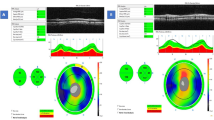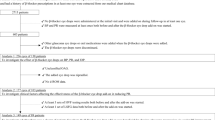Abstract
Objective To assess the comprehensive effects of raloxifene hydrochloride on retinal, choroidal and retrobulbar hemodynamics and on visual function in post-menopausal women. Design Twenty-four post-menopausal women (age 55 ± 3.8 years) were recruited for this cross-sectional study: 12 received placebo and 12 received raloxifene hydrochloride 60 mg once a day for 3 months. Baseline measurements of both groups included heart rate (HR), blood pressure (BP), visual acuity, contrast sensitivity and intraocular pressure (IOP) for both eyes. A comprehensive ocular blood flow (OBF) assessment was obtained for each patient in a randomly chosen study eye. Retinal blood flow data was obtained using confocal scanning laser Doppler flowmetry [Heidelberg Retinal Flowmeter (HRF)]. Color Doppler imaging (CDI) was used to assess retrobulbar hemodynamics in the ophthalmic, central retinal, short nasal and temporal posterior ciliary arteries. Baseline vision and hemodynamics in post-menopausal subjects were compared using paired Student’s t tests, and the percentage change in baseline versus 3-month parameters was analyzed. Results There were no statistically significant differences between 3 months of raloxifene therapy and placebo in terms of age, HR, arterial or mean BP, visual acuity, contrast sensitivity, IOP or retinal or retrobulbar blood flow. Conclusion Raloxifene therapy at 60 mg/day had no clinically significant impact on BP, IOP or OBF in post-menopausal women.
Similar content being viewed by others
References
Muchmore DB (2000) Raloxifene: a selective estrogen receptor modulator (SERM) with multiple target system effects. Oncologist 5:388–392
Raloxifene (1997) Package insert. Eli Lilly and Company, Indianapolis
Kleinert H, Wallerath T, Euchenhofer C, Ihrig-Biedert I, Li H, Forstermann U (1998) Estrogens increase transcription of the human endothelial NO synthase gene: analysis of the transcription factors involved. Hypertension 31:582–588
Khorram O, Garthwaite M, Magness RR (1999) Endometrial and myometrial expression of nitric oxide synthase isoforms in pre- and postmenopausal women. J Clin Endocrinol Metab 84:2226–2232
Wassmann S, Laufs U, Stamenkovic D et al (2002) Raloxifene improves endothelial dysfunction in hypertension by reduced oxidative stress and enhanced nitric oxide production. Circulation 105:2083–2091
Sarrel PM, Nawaz H, Chan W, Fuchs M, Katz DL (2003) Raloxifene and endothelial function in healthy postmenopausal women. Am J Obstet Gynecol 188:304–309
Saitta A, Altavilla D, Cucinotta D et al (2001) Randomized, double-blind, placebo-controlled study on effects of raloxifene and hormone replacement therapy on plasma NO concentrations, endothelin–1 levels, and endothelium-dependent vasodilation in postmenopausal women. Arterioscler Thromb Vasc Biol 21:1512–1519
Lang Y, Lang N, Ben-Ami M, Garzozi H (2002) The effects of hormone replacement therapy (HRT) on the human eye. Harefuah 141:287–291
Harris A, Harris M, Biller J et al (2000) Aging affects the retrobulbar circulation differently in women and men. Arch Ophthalmol 118:1076–1080
Centofanti M, Migliardi R, Bonini S et al (2002) Pulsatile ocular blood flow during pregnancy. Eur J Ophthalmol 12:276–280
Toker E, Yenice O, Akpinar I, Aribal E, Kazokoglu H (2003) The influence of sex hormones on ocular blood flow in women. Acta Ophthalmol Scand 81:617–624
Belfort MA, Saade GR, Snabes M et al (1995) Hormonal status affects the reactivity of the cerebral vasculature. Am J Obstet Gynecol 172:1273–1278
Harris-Yitzhak M, Harris A, Ben-Reael Z, Zarfati D, Garzozi HJ, Martin BJ (2000) Estrogen-replacement therapy: effects on retrobulbar hemodynamics. Am J Ophthalmol 129:623–628
Atalay E, Karaali K, Akar M et al (2005) Early impact of hormone replacement therapy on vascular hemodynamics detected via ocular colour Doppler analysis. Maturitas 50:282–288
van Baal WM, Kenemans P, Stehouwer CD, Peters-Muller ER, van Vugt JM, van der Mooren MJ (1999) Sequentially combined hormone replacement therapy reduces impedance to flow within the uterine and central retinal arteries in healthy postmenopausal women. Am J Obstet Gynecol 181:1365–1373
Battaglia C, Mancini F, Regnani G, Persico N, Volpe A, De Aloysio D (2004) Hormone therapy and ophthalmic artery blood flow changes in women with primary open-angle glaucoma. Menopause 11:69–77
Altinta O, Caglar Y, Yuksel N, Demirci A, Karabas L (2004) The effects of menopause and hormone replacement therapy on quality and quantity of tear, intraocular pressure and ocular blood flow. Ophthalmologica 218:120–129
Kagemann L, Harris A, Chung HS, Evans D, Buck S, Martin B (1998) Heidelberg retinal flowmetry: factors affecting blood flow measurement. Br J Ophthalmol 82:131–136
Harris A, Williamson T, Martin B, Shoemaker J, Sergott R, Spaeth G, Katz J (1995) Test/retest reproducibility of color Doppler imaging assessment of blood flow velocity in orbital vessels. J Glaucoma 4:281−286
Cagnacci A, Zanni AL, Volpe A (2003) Administration of raloxifene does not influence 24 hour ambulatory blood pressure of postmenopausal women with osteopenia: a double blind placebo-controlled study. Am J Obstet Gynecol 188:1278–1282
Morgante G, Delia A, Musacchio MC, Severi FM, Petraglia F, De Leo V (2006) Effects of raloxifene therapy on plasma rennin and aldosterone levels and blood pressure in postmenopausal women. Gynecol Endocrinol 22:376–380
Colacurci N, Manzella D, Fornaro F, Carbonella M, Paolisso G (2003) Endothelial function and menopause: effects of raloxifene administration. J Clin Endocrinol Metab 88:2135–2140
Cagnacci A, Arangino S, Renzi A, Zanni AL, Volpe A (2003) Raloxifene does not influence flow-mediated endothelium-dependent and endothelium-independent vasodilatation of osteopenic postmenopausal women. Am J Obstet Gynecol 188:313–317
Figtree GA, Lu Y, Webb CM, Collins P (1999) Raloxifene acutely relaxes rabbit coronary arteries in vitro by an estrogen receptor-dependent and nitric oxide-dependent mechanism. Circulation 100:1095–1101
Zoma WD, Baker RS, Clark KE (2000) Coronary and uterine vascular responses to raloxifene in the sheep. Am J Obstet Gynecol 182:521–528
Venkov CD, Rankin AB, Vaughan DE (1996) Identification of authentic estrogen receptor in cultured endothelial cells. A potential mechanism for steroid hormone regulation of endothelial function. Circulation 94:727–733
Ceresini G, Marchini L, Rebecchi I et al (2003) Effects of raloxifene on carotid blood flow resistance and endothelium-dependent vasodilation in postmenopausal women. Atherosclerosis 167:121–127
Harris A, Jonescu-Cuypers C, Martin B, Kagemann L, Zalish M, Garzozi HJ (2001) Simultaneous management of blood flow and IOP in glaucoma. Acta Ophthalmol Scand 79:336–341
Acknowledgments
This study was supported by a research study grant from Eli Lilly Pharmaceuticals, Indianapolis, IN and in part by an unrestricted grant from Research to Prevent Blindness, New York, NY.
Author information
Authors and Affiliations
Corresponding author
Rights and permissions
About this article
Cite this article
Siesky, B., Harris, A., Kheradiya, N. et al. The effects of raloxifene hydrochloride on ocular hemodynamics and visual function. Int Ophthalmol 29, 225–230 (2009). https://doi.org/10.1007/s10792-008-9224-4
Received:
Accepted:
Published:
Issue Date:
DOI: https://doi.org/10.1007/s10792-008-9224-4




